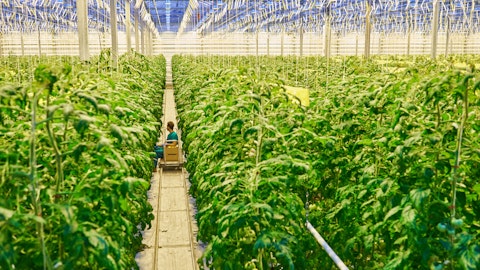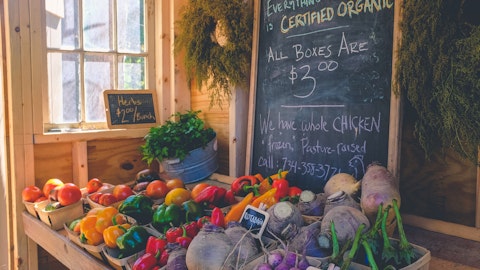Scott Mushkin: Okay –
Irwin Simon: And just on paying down debt, Scott, I think the big thing is, and Nigel referred to it. A big part of our debt over $200 million is inventories. We turn our inventories some much longer we’re buying out there. But Rajnish and Jeff have a big movement on how do we reduce our inventories. Unfortunately, we buy sugar and we buy it at one-time, but that was a big thing. We have really saleable inventories, but how do we focus on working with our suppliers in that on reducing inventories, which ultimately reduces our debt and use more cash coming from that to invest back in the marketing of the brands in this business.
Scott Mushkin: That actually is a great segue. And so it’s my next question around kind of the debt levels of the company and how we should kind of frame your thoughts as we move into ‘24 around being able to pay more down and kind of how should we think about that as we move over the next 12 months and then all yield? Thanks.
Bernardo Fiaux: Hey, Scott. Good morning, this is Bernardo. Thank you for the question. I think that free cash flow is one of the highlights of this quarter and as we expect to continue going forward. You probably heard in my prepared remarks that I’m highlighting the adjusted cash flow for this year as a good proxy for next year. The reason for that is that, we are expecting our add backs to reduce massively towards next year, while increasing EBITDA and while growing with our growth algorithm, but that’s going to be a big driver that would allow us to accelerate our debt pay down, while maintaining a more sustainable business as well.
Scott Mushkin: All right, guys. Thank you very much. Appreciate it. Good luck.
Operator: [Operator Instructions] We will go next to Ryan Meyers with Lake Street Capital Markets. Your line is open.
Ryan Meyers: Hi, guys. Thanks for taking my questions. When we think about the lower revenue guide, just kind of wondering if you can provide a bit more detail on what you are seeing there? Is it primarily volume related? Or is there something else that’s going on? And then, as it relates to kind of the overall Branded CPG segment as a whole, what kind of are you seeing from an industry demand perspective?
Bernardo Fiaux: Hey, Ryan, good morning. This is Bernardo. I’ll take this one again and I welcome the rest to complement. But, our year-to-date performance has really been about cost margins and cash flow improvements, and we have delivered that. As the category has faced headwinds this year, so too have our sales. And I think you have seen that fairly clear like in our today revenue performance. So, all-in-all, this is an effort to be transparent on where we are and what we expect to finish the year. I think that it’s important also to call out that we are doing a good job, executing our margin enhancement strategy, which is being driven in part by these bulk sugar sales, but also through all the optimizations and cost efficiency.
So and at this point, you’re also seeing that we are showing a consistent adjusted EBITDA increasing and we are bumping this guidance as well by $1 million to account for this and some other items like bonus, so we align with our goals. But most importantly, I think that this is all being translated to our very strong free cash flow generation. This has been positive this year and expect to extend this through Q4 and 2024 and with all these combination of factors, including the improved margins, lower supply chain reinvention costs, improving net working capital by reducing inventory and also to a lesser extent, some modest CapEx savings as we move to an even more asset-light model.
Irwin Simon: Let me add to that. On the sales growth part of the business, I think Jeff has shown what has happened on the licorice side. I think the big thing for us on the consumer package size was as we move to away from our de-pack, getting back in stock and getting our service levels back up to 99% where they were running in the 70s and 80s. But I got to tell you, this team has developed a big pipeline of a lot of innovation in different categories in the whole sugar-free area, have looked at distribution going into other parts of the world. Listen, our big markets today are France, UK, somewhat in Germany. So there’s a big country out there called Europe. There’s a big country out there called South America and the Middle East.
So there’s lots of growth opportunities for us. And the big thing is the expansion of the products here in sugar-free, whether it’s chocolate jams, jellies, other desserts, et cetera. And I think there’s a big opportunity still for us within Swerve. So as Bernardo said, first this year was focusing on balance sheet, focusing on making sure the supply chain got fixed. And now there’s a big effort on organic growth going into ‘24. And I think the team has a good strategic plan in place for that.
Ryan Meyers: Okay, got it. That’s helpful. And then if we think about the strong gross margin during the quarter, how much of that came from sales mix versus how much of that came from just taking costs out of the business? And you highlighted supply chain reinvention. Any commentary there would be helpful.
Rajnish Ohri: Yeah. Ryan, overall in terms of breakdown, it’s fairly widespread. When we compare across this – there were some high ticket items, including the lower tariffs in sugar, including the lower ocean freight. So those are both efficiencies. But on top of that, we are seeing manufacturing efficiencies as our services improve. We’re also seeing improvements in other prices on the contracted side for procurement. It’s like I said, fairly widespread, the improvement coming from the levels that we were at the end of the year and the start of this year.
Ryan Meyers: Got it. Thanks for taking my questions.
Rajnish Ohri: Thank you, Ryan. You have a good one.
Operator: And we will go next to Alexander Arnold with Odeon Capital. Your line is open.
Alexander Arnold: Hey, guys. Thank you. I guess I respect your comments about not opening the kimono on the committee process, but I was wondering from a timeline perspective, if you could just give an indication of what would be sort of a disappointing date if this was not wrapped up by?
Irwin Simon: I don’t think there’s – and listen, I think the big thing is this here. I hate to put a date on it. I think the only thing is the committee, the Board and everybody else wants to get it right. So, this is not like a sporting events where there’s three periods or four quarters. I think it would be disappointing. I want to make sure I think there’s lots of factors in here. We want to make sure there’s full shareholder value. You can see the improvements happening in this business. You see the margin improvement now and you take that across the full year, next year and some of the costs coming out of this business. You heard Bernardo talk about add backs, how they’ve come weigh down or pay down of debt, a reduction of inventory.
So there’s a lot of factors in here as we move forward to put out there in regards to what’s the right value for shareholders. And that’s what the strategic committee wants to make sure, that’s what the Board wants to make sure and they want to make sure, working with management, we have all those factors to make sure to sort of say, “Hey, this is the value that shareholders should ultimately get in the share price or if there is a strategic opportunity to sell this company, this is what shareholders should be paid.” But we got to make sure we have all the right facts in there, not only for fiscal ‘23, ‘24, ‘25, and there’s a lot of good things coming out of this company as we’ve moved out of COVID, as we moved out of de-pack, as we expand the distribution company as we go into new products.



